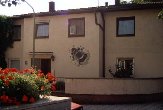 This living house can be found very close to where I live, at Teisendorfer Straße. From the first time I saw that big bumblebee I liked it. I never liked wasps, but bumblebees was never any problem. Especially whose that pass the winter to come back next spring, bigger then ever, sounding like a bomber, slowly cruising the sky, they are beautiful.
This living house can be found very close to where I live, at Teisendorfer Straße. From the first time I saw that big bumblebee I liked it. I never liked wasps, but bumblebees was never any problem. Especially whose that pass the winter to come back next spring, bigger then ever, sounding like a bomber, slowly cruising the sky, they are beautiful.
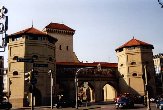 Isar Gate (Isartor) was the eastern boundary of the city fortifications at the time of Ludwig the Bavarian in the fourteenth century. It is the only gate of the city whose tower has survived. The wall-painting. "The Triumphal Entry of Emperor Ludwig of Bavaria after the Battle of Ampfingen in 1322", is a work of the nineteenth century.
Isar Gate (Isartor) was the eastern boundary of the city fortifications at the time of Ludwig the Bavarian in the fourteenth century. It is the only gate of the city whose tower has survived. The wall-painting. "The Triumphal Entry of Emperor Ludwig of Bavaria after the Battle of Ampfingen in 1322", is a work of the nineteenth century.
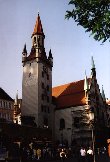 Old City Hall (Alte Rathaus) was built by Jörg von Halspach (called Ganghofer) in 1470-80. Most of the building was destroyed in the Second World War. Located over the gateway, the Rathaussaal has beautifully ornamented timber barrel vaulting, which is a masterpiece of German late-Lothic architecture. This was the original home of the Maruska dancers - 16 wood figures carved by Eramus Grasser in 1480 - of which, unfortunately, only 10 have been preserved (on show in the City Museum). A Toy museum (Spielzuegmuseum) is now housed in the Rathaus tower, which was rebuild in 1975.
Old City Hall (Alte Rathaus) was built by Jörg von Halspach (called Ganghofer) in 1470-80. Most of the building was destroyed in the Second World War. Located over the gateway, the Rathaussaal has beautifully ornamented timber barrel vaulting, which is a masterpiece of German late-Lothic architecture. This was the original home of the Maruska dancers - 16 wood figures carved by Eramus Grasser in 1480 - of which, unfortunately, only 10 have been preserved (on show in the City Museum). A Toy museum (Spielzuegmuseum) is now housed in the Rathaus tower, which was rebuild in 1975.
 New City Hall is dominating the Marienplatz, regarded as the centre of München. It was commissioned by King Ludwig I, whose construction necessitated the demolition of 24 historic houses. This neo-Gothic building (brick with carved stone ornament, the west section with tower made of muschelkalk) was erected in three phases between 1867 and 1909 under the supervision on Georg Hauberisser. Its most striking feature is the 85-meter high tower with the famous Munich carillon (Glockenspiel). Every day at 12pm (from May to October, also 5pm), 32 almost life-size figures present scenes from the city's history: the wedding of Duke Wilhelm V and Renata of Lorraine with jousting tournament, and the Coopers' Dance (Schefflertanz) that has been performed every 7 years since 1517 to celebrate the end of the Black Death. In the evening a night watchman and angel of peace emerge to bless the small figure of a monk (Münchner Kindl - a symbol of the city). The facade of the New City Hall is about 100 meters long and its rich ornamentation includes figures of Bavarian dukes, princes and kings, as well as allegorical and legendary figures, and saints. The building's courtyards with their turrets, staircases and spacious enclosed stairways, are modelled on Gothic castle courtyards.
New City Hall is dominating the Marienplatz, regarded as the centre of München. It was commissioned by King Ludwig I, whose construction necessitated the demolition of 24 historic houses. This neo-Gothic building (brick with carved stone ornament, the west section with tower made of muschelkalk) was erected in three phases between 1867 and 1909 under the supervision on Georg Hauberisser. Its most striking feature is the 85-meter high tower with the famous Munich carillon (Glockenspiel). Every day at 12pm (from May to October, also 5pm), 32 almost life-size figures present scenes from the city's history: the wedding of Duke Wilhelm V and Renata of Lorraine with jousting tournament, and the Coopers' Dance (Schefflertanz) that has been performed every 7 years since 1517 to celebrate the end of the Black Death. In the evening a night watchman and angel of peace emerge to bless the small figure of a monk (Münchner Kindl - a symbol of the city). The facade of the New City Hall is about 100 meters long and its rich ornamentation includes figures of Bavarian dukes, princes and kings, as well as allegorical and legendary figures, and saints. The building's courtyards with their turrets, staircases and spacious enclosed stairways, are modelled on Gothic castle courtyards.
 The best known landmark in München is Cathedral Church of Our Lady, also known as the Frauenkirche. It has been the Metropolitan Church of the newly founded Archbishopric of München-Freising since 1821, and the turbulent history on which it can look back is closely bound up with that of the Wittelsback monarchs and their desire for a fitting sepulchre. A major building dating from the first half of the 13th century preceded this one, on which work started in 1468. Jörg von Halspach was commissioned to build it; he constructed the enormous church (109 meters long, 40 meters wide) in the shortest possible time, using a brick construction. The foundation stone was laid in 1468 by duke Sigismund and Bishop Johannes Tulbeck, and the church was ceremoniously consecrated in 1494, although the "onion domes" on the two towers were not added until 1525. The three-nave Frauenkirche with its irregular polygonal choir keeps totally to the tradition of southern German wide-span churches. The clear structure of the body of the church and its massive roof is dictated by the integration of the chapel crown and the decision to dispense with a crossing.
The best known landmark in München is Cathedral Church of Our Lady, also known as the Frauenkirche. It has been the Metropolitan Church of the newly founded Archbishopric of München-Freising since 1821, and the turbulent history on which it can look back is closely bound up with that of the Wittelsback monarchs and their desire for a fitting sepulchre. A major building dating from the first half of the 13th century preceded this one, on which work started in 1468. Jörg von Halspach was commissioned to build it; he constructed the enormous church (109 meters long, 40 meters wide) in the shortest possible time, using a brick construction. The foundation stone was laid in 1468 by duke Sigismund and Bishop Johannes Tulbeck, and the church was ceremoniously consecrated in 1494, although the "onion domes" on the two towers were not added until 1525. The three-nave Frauenkirche with its irregular polygonal choir keeps totally to the tradition of southern German wide-span churches. The clear structure of the body of the church and its massive roof is dictated by the integration of the chapel crown and the decision to dispense with a crossing.
The plain and simple external architecture is in harmony with the disciplined interior. The unyielding central nave leads directly along underneath the star vaulting to the choir window. This is all the more effective because of the tight arrangement of the octagonal pillars which, although they are tellingly modelled by the light falling on them from the side, prevent the windows themselves from being seen. The rich interior decoration, which was constantly being altered to meet changes in artistic taste, dates from a number of different epochs, although much of it was sacrificed to the religious movements of the 19th century or to the ravages of the last war. The last phase of restoration was taken as an opportunity to bring home various important works of art such as the statues from the choir stool by Erasmus Grasser (1502); it is to him that the automatic clock alongside the chapel of the sacrament is ascribed. This is the oldest mechanical picture still extant, and above the clock face there are moving figures of the Virgin Mary, Christ, and God the Father (about 1500).
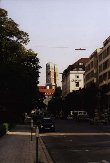 The three outstanding sculptures in the Chapel of the Court Brotherhood of St Anna and St George are also worth mentioning. They stand on the left of the Chapel, and represent the two patron saints of the Order - St Rasso (by the master-craftsman von Rabenden, about 1515) and St George (by Hans Leinberger, also about 1515) - and St Christopher (also by Hans Leinberger, about 1520-25). The 17th century decoration work includes the monumental High Altar by the Court painter Peter Candid (1620), the main panel of which hangs above the sacristy door and represents the Ascension of the Virgin. The cenotaph made of bronze and black marble (1622) commemorates the Emperor Ludwig the Bavarian and includes a red marble memorial tablet of much earlier date (1490). This massive structure by Hans Krumper, with figures by Hubert Gerhard and others, used to be set up longitudinally in the choir, but is now to be found in front of the southern tower chapel. The Rococo age endowed the interior with the gilded bas relief's (1774) which Ignaz Günther created for the choir stool. Roman Anton Boos produced a pulpit, of which the statue of the Virgin Mary (1780) is still preserved; it originally stood atop the pulpit canopy, but now stands on a pillar in the choir.
The three outstanding sculptures in the Chapel of the Court Brotherhood of St Anna and St George are also worth mentioning. They stand on the left of the Chapel, and represent the two patron saints of the Order - St Rasso (by the master-craftsman von Rabenden, about 1515) and St George (by Hans Leinberger, also about 1515) - and St Christopher (also by Hans Leinberger, about 1520-25). The 17th century decoration work includes the monumental High Altar by the Court painter Peter Candid (1620), the main panel of which hangs above the sacristy door and represents the Ascension of the Virgin. The cenotaph made of bronze and black marble (1622) commemorates the Emperor Ludwig the Bavarian and includes a red marble memorial tablet of much earlier date (1490). This massive structure by Hans Krumper, with figures by Hubert Gerhard and others, used to be set up longitudinally in the choir, but is now to be found in front of the southern tower chapel. The Rococo age endowed the interior with the gilded bas relief's (1774) which Ignaz Günther created for the choir stool. Roman Anton Boos produced a pulpit, of which the statue of the Virgin Mary (1780) is still preserved; it originally stood atop the pulpit canopy, but now stands on a pillar in the choir.
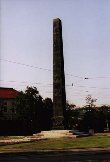 The Obelisk in the centre of Karolinenplatz was designed by Klenze and is a monument to the Bavarian soldiers who died during Napoleon's Russian campaign. Karolinenplatz, which was built according to plans by Karl von Fischer in 1809-12, was largely modelled on the Place de l'Etoile in Paris.
The Obelisk in the centre of Karolinenplatz was designed by Klenze and is a monument to the Bavarian soldiers who died during Napoleon's Russian campaign. Karolinenplatz, which was built according to plans by Karl von Fischer in 1809-12, was largely modelled on the Place de l'Etoile in Paris.
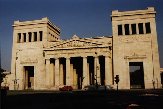 The massive square, Königsplatz, was conceived by Ludwig I as a cultural focal point of his "Athens on the Isar". Along with the buildings of Ludwigsstraße, it represents his most monumental contribution to München in its present form. Originally planned by Karl von Fischer in 1811, it was Ludwig won Klenze who, a few years later, drew up the final design according to models from the classical world: the "Doric" Propyläen, the "Ionic" Glyptothek and the "Corinthian" State Museum of Classical Art. During the Third Reich, the square was laid with stone slabs, so that it served as an appropriately "martial" setting for parades and ceremonies. These stones were removed in 1988.
The massive square, Königsplatz, was conceived by Ludwig I as a cultural focal point of his "Athens on the Isar". Along with the buildings of Ludwigsstraße, it represents his most monumental contribution to München in its present form. Originally planned by Karl von Fischer in 1811, it was Ludwig won Klenze who, a few years later, drew up the final design according to models from the classical world: the "Doric" Propyläen, the "Ionic" Glyptothek and the "Corinthian" State Museum of Classical Art. During the Third Reich, the square was laid with stone slabs, so that it served as an appropriately "martial" setting for parades and ceremonies. These stones were removed in 1988.
Inspired by the Propylaea (Greek, "temple entrance") on the Athenian Acropolis, Klenze conceived the Propyläen, which was built in 1846-62, as the entrance gateway to the new city of culture. The pediment sculptures on each side celebrate both the War of Independence fought by Greece against the Ottoman Empire, as well as Ludwig's son, Otto, who became King of Greece in 1832.
 Klenze's first construction for Königsplatz was the Glyptothek, which was erected between 1816 and 1830. It contains one of the most important sculpture collections to be found in Europe. Even while crown prince, Ludwig expressed his love of the culture of antiquity by employing agents to acquire Greek and Roman artworks. With the Glyptothek, Klenze created a worthy setting for these exceptional works. The building has a portico of Ionic Columns and comprises four wings with a central open courtyard that serves to light the interior, as the exterior wall has no windows, being decorated instead with statues in niches. Destroyed in the war (the sculpture collection was preserved), the Glyptothek was reopened in 1972.
Klenze's first construction for Königsplatz was the Glyptothek, which was erected between 1816 and 1830. It contains one of the most important sculpture collections to be found in Europe. Even while crown prince, Ludwig expressed his love of the culture of antiquity by employing agents to acquire Greek and Roman artworks. With the Glyptothek, Klenze created a worthy setting for these exceptional works. The building has a portico of Ionic Columns and comprises four wings with a central open courtyard that serves to light the interior, as the exterior wall has no windows, being decorated instead with statues in niches. Destroyed in the war (the sculpture collection was preserved), the Glyptothek was reopened in 1972.
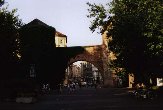 Sendlinger Gate (Sendlinger Tor), which was first mentioned in 1318, was constructed at the time when the city was expanded by Ludwig the Bavarian. The two flanking towers dating from about 1420 are the only surviving remnants of the original group of fortifications that comprised the gateway.
Sendlinger Gate (Sendlinger Tor), which was first mentioned in 1318, was constructed at the time when the city was expanded by Ludwig the Bavarian. The two flanking towers dating from about 1420 are the only surviving remnants of the original group of fortifications that comprised the gateway.
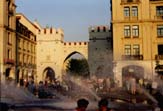 Close to Sonnenstrasse, you will find Karlsplatz, which is popularly called "Stachus". This square was laid out in 1791 after the demolition of the city fortifications by the Karlstor (Karl's Gate). Opposite Karlsplatz stands the imposing Palace of Jostice (Justizpalast), a monumental example of late nineteenth-century architecture, which its designer, Freidrich von Thiersch, modeled on the Italian style of the late Renaissance. Its most striking feature is the polygonal dome made of iron and glass over the central air well, a construktion without precedent at the time.
Close to Sonnenstrasse, you will find Karlsplatz, which is popularly called "Stachus". This square was laid out in 1791 after the demolition of the city fortifications by the Karlstor (Karl's Gate). Opposite Karlsplatz stands the imposing Palace of Jostice (Justizpalast), a monumental example of late nineteenth-century architecture, which its designer, Freidrich von Thiersch, modeled on the Italian style of the late Renaissance. Its most striking feature is the polygonal dome made of iron and glass over the central air well, a construktion without precedent at the time.
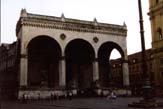 The Palais Preysing located to the south of the Commander's Hall at the end of Ludwigsstrasse is the first Rococo palace to have been built in München; it was constructed for Count Maximilian von Preysing by Joseph Effner in 1723-28. A beautiful feature of the interior of the palace - now a shopping mall - that has been preserved is the splendid triple staircase with wall decoration.
The Palais Preysing located to the south of the Commander's Hall at the end of Ludwigsstrasse is the first Rococo palace to have been built in München; it was constructed for Count Maximilian von Preysing by Joseph Effner in 1723-28. A beautiful feature of the interior of the palace - now a shopping mall - that has been preserved is the splendid triple staircase with wall decoration.
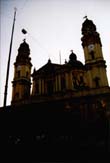 Situated to the west of the Commander's Hall, the Theatinerkirche is a basilica in the style of the high Baroque and is considered by many to be one of the most beautiful churches in München. The building was a gift of Elector Ferdinand Maria and his wife in gratitude for the birth of their long-awaited heir, Max Emanuel. After its consecreation, the church (dedicated to St. Cajetan) was placed in the hands of monks of the Theatine Order. The overall conception of this domed, cruciform building is attributed to the Italian architect, Agostino Barelli, who supervised the first construction phase between 1663 and 1669. His successor, Enrico Zuccali, completed the 71-meter high dome, erected the towers and decorated the interior. The facade was only completed in 1770 by Francois Cuvilliés in the late Rococo style. The marble figures in the facade miches (Saints Ferdinand, Adelheid, Maximilian and Cajetan) are the work of Roman Boos.
Situated to the west of the Commander's Hall, the Theatinerkirche is a basilica in the style of the high Baroque and is considered by many to be one of the most beautiful churches in München. The building was a gift of Elector Ferdinand Maria and his wife in gratitude for the birth of their long-awaited heir, Max Emanuel. After its consecreation, the church (dedicated to St. Cajetan) was placed in the hands of monks of the Theatine Order. The overall conception of this domed, cruciform building is attributed to the Italian architect, Agostino Barelli, who supervised the first construction phase between 1663 and 1669. His successor, Enrico Zuccali, completed the 71-meter high dome, erected the towers and decorated the interior. The facade was only completed in 1770 by Francois Cuvilliés in the late Rococo style. The marble figures in the facade miches (Saints Ferdinand, Adelheid, Maximilian and Cajetan) are the work of Roman Boos.
The interior, of which the higt round arches of the barrel vaulting and the dome are the dominant features, is laid out according to Roman models: main nave with chapels, crossing cupola and semi-circular apse. The entire interior was painted white and lavishly ornamented with stucco work by Viscardi. The high altar, an imposing columned structure, is crowned with figures of the four patron saints of the Electoral family. The latar painting is a work by Caspar de Crayer (1646), a pupil of Rubens. The black pulpit (1685-90) is by Andreas Faistenberger. Also worthy of note is the altar dedicated to St. Cajetan with a painting by J. von Sandrat (1667-71). The crypt under the high altar contains the massive stone sarcophagus of King Max II and his wife along with several bronze coffins containing members of the Wittelsbach family.
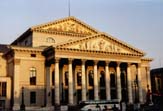 The National Theater (Nationaltheater)om Max-Joseph-Platz was built in the classical style by Karl von Fischer in1811-18. Destroyd in the Second World War, it was rebuilt in its origilnal form and reopened in 1963. To the north or the National Theater stands the Residence Theater (Residenztheater), which in 1948-51 was incorporated into the partially preserved outside walls of the Cuvilliés Theather; the latter theater was moved into the Aporhecary Wing of the Residence.
The National Theater (Nationaltheater)om Max-Joseph-Platz was built in the classical style by Karl von Fischer in1811-18. Destroyd in the Second World War, it was rebuilt in its origilnal form and reopened in 1963. To the north or the National Theater stands the Residence Theater (Residenztheater), which in 1948-51 was incorporated into the partially preserved outside walls of the Cuvilliés Theather; the latter theater was moved into the Aporhecary Wing of the Residence.
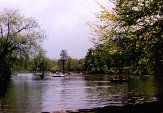 The English Garden is much more than the largest city park in Germany. Ask any München citizen what he or she finds especially attractive about the city and you can be sure that this garden will be high on the list. Starting from the Haus der Kunst, it is possible to walk or cycle through the new and old parts of the garden along the Isar as far as Freising without having to come in contact with the city traffic. Along with its well-known summer attraction - nude bathing along the Eisback - the park offers a comprehensive cross-section of the München population; walkers, joggers, hippies, bankers enjoying their lunch-break, pensioners, tourists and embracing couples. In short, anyone and everyone.
The English Garden is much more than the largest city park in Germany. Ask any München citizen what he or she finds especially attractive about the city and you can be sure that this garden will be high on the list. Starting from the Haus der Kunst, it is possible to walk or cycle through the new and old parts of the garden along the Isar as far as Freising without having to come in contact with the city traffic. Along with its well-known summer attraction - nude bathing along the Eisback - the park offers a comprehensive cross-section of the München population; walkers, joggers, hippies, bankers enjoying their lunch-break, pensioners, tourists and embracing couples. In short, anyone and everyone.
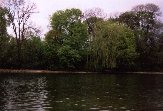 On the suggestion of the later Count Rumford, the Prince Elector Karl Theodor had a "Military Garden" laid out along the Isar in 1789, which soon after was opened to the public. A lake, the Kleinhesselohe See, was added shortly after this. In the park you can find the Chinese Tower and The Monopteros.
On the suggestion of the later Count Rumford, the Prince Elector Karl Theodor had a "Military Garden" laid out along the Isar in 1789, which soon after was opened to the public. A lake, the Kleinhesselohe See, was added shortly after this. In the park you can find the Chinese Tower and The Monopteros.
















